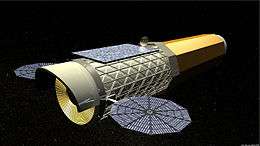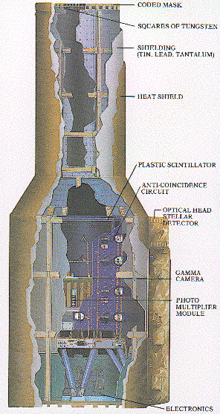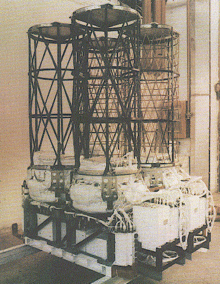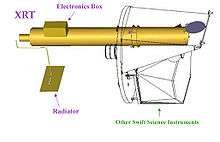X-ray telescope

An X-ray telescope (XRT) is a telescope that is designed to observe remote objects in the X-ray spectrum. In order to get above the Earth's atmosphere, which is opaque to X-rays, X-ray telescopes must be mounted on high altitude rockets, balloons or artificial satellites.
The basic elements of the telescope are the optics (focusing or collimating), that collects the radiation entering the telescope, and the detector, on which the radiation is collected and measured. A variety of different designs and technologies have been used for these elements.
Many of the existing telescopes on satellites are compounded of multiple copies or variations of a detector-telescope system, whose capabilities add or complement each other and additional fixed or removable elements[1][2] (filters, spectrometers) that add functionalities to the instrument.
Optics
The most common methods used in X-ray optics are grazing incidence mirrors and collimated apertures.
Focusing mirrors

The utilization of X-ray mirrors allows to focus the incident radiation on the detector plane.
Different geometries (e.g. Kirkpartick-Baez or Lobster-eye) have been suggested or employed, but almost the totality of existing telescopes employs some variation of the Wolter I design. The limitations of this type of X-ray optics result in much narrower fields of view (typically <1 degree) than visible or UV telescopes.
With respect to collimated optics, focusing optics allow:
- a high resolution imaging
- a high telescope sensitivity: since radiation is focused on a small area, Signal-to-noise ratio is much higher for this kind of instruments.
The mirrors can be made of ceramic or metal foil[3] coated with a thin layer of a reflective material (typically gold or iridium). Mirrors based on this construction work on the basis of total reflection of light at grazing incidence.
This technology is limited in energy range by the inverse relation between critical angle for total reflection and radiation energy. The limit in the early 2000s with Chandra and XMM-Newton X-ray observatories was about 15 kilo-electronvolt (keV) light.[4] Using new multi-layered coated mirrors, the X-ray mirror for the NuSTAR telescope pushed this up to 79 keV light.[4] To reflect at this level, glass layers were multi-coated with tungsten (W)/silicon (Si) or platinum (Pt)/silicon carbide(SiC).[4]
Collimating Optics
While earlier X-ray telescopes were using simple collimating techniques (e.g. rotating collimators, wire collimators),[5] the technology most currently used on present days employs coded aperture maske. This technique uses a flat aperture patterned grille in front of the detector. This design results less sensitive than focusing optics and imaging quality and identification of source position is much poorer, however it offers a larger field of view and can be employed at higher energies, where grazing incidence optics become ineffective. Also the imaging is not direct, but the image is rather reconstructed by post-processing of the signal.
Detectors
Several technologies have been employed on detectors for X-ray telescopes, ranging from counters like Ionization chambers, geiger counters or scintillators to imaging detectors like CCDs or CMOS sensors. The use of micro-calorimeters, that offer the added capability of measuring with great accuracy the energy of the radiation, is planned for future missions.
Missions Employing X-ray Telescopes




Exosat
The two low-energy imaging telescopes onboard Exosat used Wolter I X-ray optics and were equipped with two focal plane detectors:
- a position-sensitive proportional counter (PSD) and
- a channel multiplier array (CMA).[6]
Hard X-ray telescope
On board OSO 7 was a hard X-ray telescope. Its effective energy range: 7–550 keV, field of view (FOV) 6.5°, effective area ~64 cm2.
Filin telescope
The Filin telescope carried aboard Salyut 4, consisted of four gas flow proportional counters, three of which had a total detection surface of 450 cm2 in the energy range 2–10 keV, and one of which has an effective surface of 37 cm2 for the range 0.2–2 keV. The FOV was limited by a slit collimator to 3° × 10° FWHM. The instrumentation included optical sensors mounted on the outside of the station together with the X-ray detectors. The power supply and measurement units were inside the station. Ground based calibration of the detectors occurred along with in-flight operation in three modes: inertial orientation, orbital orientation, and survey. Data were collected in 4 energy channels: 2–3.1 keV, 3.1–5.9 keV, 5.9–9.6 keV, and 2–9.6 keV in the larger detectors. The smaller detector had discriminator levels set at 0.2 keV, 0.55 keV, and 0.95 keV.
SIGMA telescope
The hard X-ray and low-energy gamma-ray SIGMA telescope covered the energy range 35–1300 keV,[7] with an effective area of 800 cm2 and a maximum sensitivity field of view of ~5° × 5°. The maximum angular resolution was 15 arcmin.[8] The energy resolution was 8% at 511 keV.[9] Its imaging capabilities were derived from the association of a coded mask and a position sensitive detector based on the Anger camera principle.[10]
ART-P X-ray telescope
The ART-P X-ray telescope covered the energy range 4 to 60 keV for imaging and 4 to 100 keV for spectroscopy and timing. There were four identical modules of the ART-P telescope, each consisting of a position sensitive multi-wire proportional counter (MWPC) together with a URA coded mask. Each module had an effective area of approximately 600 cm2, producing a FOV of 1.8° × 1.8°. The angular resolution was 5 arcmin; temporal and energy resolutions were 3.9 ms and 22% at 6 keV, respectively.[11] The instrument achieved a sensitivity of 0.001 of the Crab nebula source (= 1 "mCrab") in an eight-hour exposure. The maximum time resolution was 4 ms.[9][10]
Focusing X-ray telescope
The Broad Band X-ray Telescope (BBXRT) was flown on the Space Shuttle Columbia (STS-35) as part of the ASTRO-1 payload. BBXRT was the first focusing X-ray telescope operating over a broad energy range 0.3–12 keV with a moderate energy resolution (90 eV at 1 keV and 150 eV at 6 keV). The two Co-Aligned Telescopes with a segmented Si(Li) solid state spectrometer each (detector A and B) composite of five pixels. Total FOV 17.4´ diameter, Central pixel FOV 4´ diameter. Total area 765 cm2 at 1.5 keV, and 300 cm2 at 7 keV.
XRT on the Swift MIDEX mission
The XRT on the Swift MIDEX mission (0.2–10 keV energy range) uses a Wolter I telescope to focus X-rays onto a thermoelectrically cooled CCD.[12] It was designed to measure the fluxes, spectra, and lightcurves of Gamma-ray bursts (GRBs) and afterglows over a wide dynamic range covering more than 7 orders of magnitude in flux. The XRT can pinpoint GRBs to 5-arcsec accuracy within 10 seconds of target acquisition for a typical GRB and can study the X-ray counterparts of GRBs beginning 20–70 seconds from burst discovery and continuing for days to weeks.
The overall telescope length is 4.67 m with a focal length of 3.500 mm and a diameter of 0.51 m.[12] The primary structural element is an aluminum optical bench interface flange at the front of the telescope that supports the forward and aft telescope tubes, the mirror module, the electron deflector, and the internal alignment monitor optics and camera, plus mounting points to the Swift observatory.[12]
The 508 mm diameter telescope tube is made of graphite fiber/cyanate ester in two sections. The outer graphite fiber layup is designed to minimize the longitudinal coefficient of thermal expansion, whereas the inner composite tube is lined internally with an aluminum foil vapor barrier to guard against outgassing of water vapor or epoxy contaminants into the telescope interior.[12] The telescope has a forward tube which encloses the mirrors and supports the door assembly and star trackers, and an aft tube which supports the focal plane camera and internal optical baffles.[12]
The mirror module consists of 12 nested Wolter I grazing incidence mirrors held in place by front and rear spiders. The passively heated mirrors are gold-coated, electroformed nickel shells 600 mm long with diameters ranging from 191 to 300 mm.[12]
The X-ray imager has an effective area of >120 cm2 at 1.15 keV, a field of view of 23.6 × 23.6 arcmin, and angular resolution (θ) of 18 arcsec at half-power diameter (HPD). The detection sensitivity is 2 × 10−14 erg cm−2s−1 in 104 s. The mirror point spread function (PSF) has a 15 arcsec HPD at the best on-axis focus (at 1.5 keV). The mirror is slightly defocused in the XRT to provide a more uniform PSF for the entire field of view hence the instrument PSF θ = 18 arcsec.[12]
Normal incidence X-ray telescope
Like MSSTA, NIXT used normal incidence reflective multilayer optics.[13]
History of X-ray telescopes
The first X-ray telescope employing Wolter Type I grazing-incidence optics was employed in a rocket-borne experiment in 1965 to obtain X-ray images of the sun (R. Giacconi et al., ApJ 142, 1274 (1965)).
The Einstein Observatory (1978–1981), also known as HEAO-2, was the first orbiting X-ray observatory with a Wolter Type I telescope (R. Giacconi et al., ApJ 230,540 (1979)). It obtained high-resolution X-ray images in the energy range from 0.1 to 4 keV of stars of all types, super-nova remnants, galaxies, and clusters of galaxies. HEAO-1 (1977-1979) and HEAO-3 (1979-1981) were others in that series. Another large project was ROSAT (active from 1990-1999), which was a heavy X-ray space observatory with focusing X-ray optics.
The Chandra X-Ray Observatory is among the recent satellite observatories launched by NASA, and by the Space Agencies of Europe, Japan, and Russia. Chandra has operated for more than 10 years in a high elliptical orbit, returning thousands 0.5 arc-second images and high-resolution spectra of all kinds of astronomical objects in the energy range from 0.5 to 8.0 keV. Many of the spectacular images from Chandra can be seen on the NASA/Goddard website.
NuStar is one of the latest X-ray space telescopes, launched in June 2012. The telescope observes radiation in a high-energy range (3 - 79 keV), and with high resolution. NuStar is sensitive to the 68 and 78 keV signals from decay of 44Ti in supernovae.
Gravity and Extreme Magnetism (GEMS) would have measured X-ray polarization but was cancelled in 2012.
See also
- List of telescope types
- List of X-ray space telescopes
- X-ray astronomy
- Wolter telescope: A type of X-ray telescope built with glancing incidence mirrors.
References
- ↑ "Chandra :: About Chandra :: Science Instruments". chandra.si.edu. Retrieved 2016-02-19.
- ↑ "Instruments". sci.esa.int. Retrieved 2016-02-19.
- ↑ "Mirror Laboratory".
- 1 2 3 NuStar: Instrumentation: Optics Archived November 1, 2010, at the Wayback Machine.
- ↑ Seward, Frederick D.; Charles, Philip A. Exploring the X-ray Universe - Cambridge Books Online - Cambridge University Press. doi:10.1017/cbo9780511781513.
- ↑ Hoff HA (Aug 1983). "Exosat — the new extrasolar x-ray observatory". J Brit Interplan Soc (Space Chronicle). 36 (8): 363–7. Bibcode:1983JBIS...36..363H.
- ↑ Mandrou P; et al. (1993). "Overview of two-year observations with SIGMA on board GRANAT". Astronomy and Astrophysics Supplement Series. 97 (97): 1. Bibcode:1993A&AS...97....1M.
- ↑ Revnivtsev MG; Sunyaev RA; Gilfanov MR; Churazov EM; Goldwurm A; Paul J; Mandrou P; Roques JP (2004). "A hard X-ray sky survey with the SIGMA telescope of the GRANAT observatory". Astron Lett. 30 (8): 527–33. arXiv:astro-ph/0403481
 . Bibcode:2004AstL...30..527R. doi:10.1134/1.1784494.
. Bibcode:2004AstL...30..527R. doi:10.1134/1.1784494. - 1 2 "International Astrophysical Observatory "GRANAT"". IKI RAN. Retrieved 2007-12-05.
- 1 2 "GRANAT". NASA HEASARC. Retrieved 2007-12-05.
- ↑ Molkov, S.V.; Grebenev, S.A.; Pavlinsky, M.N.; Sunyaev (March 1999). "GRANAT/ART-P Observations of GX3+1: Type I X-Ray it also Burst out and Persistent Emission". arXiv:astro-ph/9903089v1
 .
. - 1 2 3 4 5 6 7 Burrows DN; Hill JE; Nousek JA; Kennea JA; Wells A; Osborne JP; Abbey AF; Beardmore A; Mukerjee K; Short ADT; Chincarini G; Campana S; Citterio O; Moretti A; Pagani C; Tagliaferri G; Giommi P; Capalbi M; Tamburelli F; Angelini L; Cusumano G; Bräuninger HW; Burkert W; Hartner GD (Oct 2005). "The Swift X-ray Telescope". Space Sci Rev. 120 (3–4): 165–95. arXiv:astro-ph/0508071
 . Bibcode:2005SSRv..120..165B. doi:10.1007/s11214-005-5097-2.
. Bibcode:2005SSRv..120..165B. doi:10.1007/s11214-005-5097-2. - ↑ Hoover, R. B.; Walker II, A. B. C.; Lindblom, J. F.; Allen, M. J.; O'Neal, R. H.; DeForest, C. E.; Barbee, T. W., Jr. (1992). "Solar observations with the multispectral solar telescope array". In Hoover, Richard B. Proc. SPIE, Multilayer and Grazing Incidence X-Ray/EUV Optics. Multilayer and Grazing Incidence X-Ray/EUV Optics. 1546. p. 175. doi:10.1117/12.51232.
External links
- Kamijo N; et al. (May 2002). "Hard X-ray microbeam experiments with a sputtered-sliced Fresnel zone plate and its applications". J Synchrotron Radiat. 9 (Pt 3): 182–6. doi:10.1107/S090904950200376X. PMID 11972376.
- Scientific applications of soft x-ray microscopy